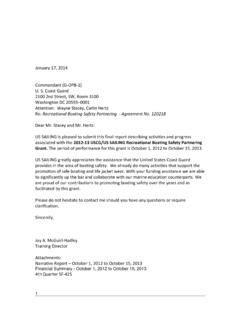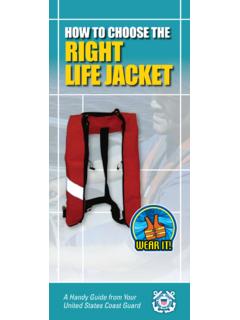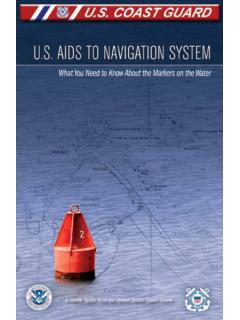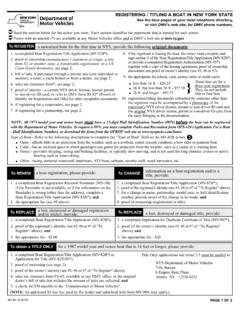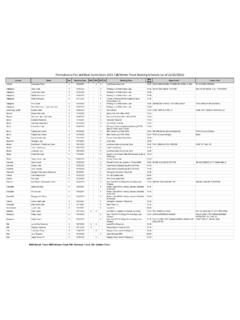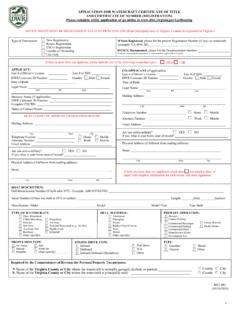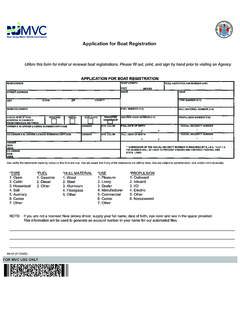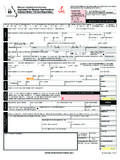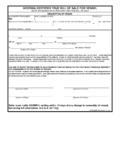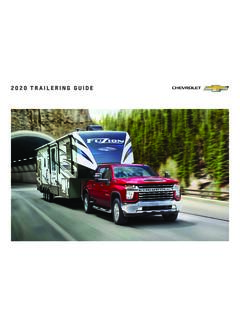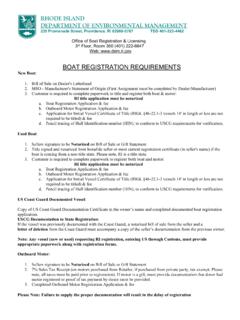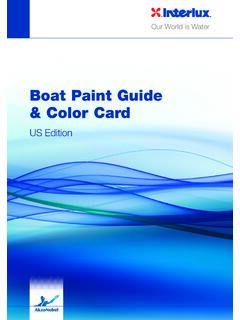Transcription of A BOATER’S GUIDE TO THE FEDERAL REQUIREMENTS FOR ...
1 I A BOATER S GUIDE TO THE FEDERAL REQUIREMENTS FOR RECREATIONAL BOATSAND SAFETY TIPSNew in this Edition: Navigation Locks Trailer Safety Digital Selective Calling Rescue 21 Naval Vessel Protection Zones America s Waterway WatchII1 TABLE OF CONTENTS WELCOME ..3 Conversion Table (U .S ./Metric) ..4 REGISTRATION AND DOCUMENTATION ..5 EQUIPMENT REQUIREMENTS ..9 Life Jackets ..9 Visual Distress Signals ..17 Fire Extinguishers ..21 Ventilation ..23 Backfire Flame Control ..25 Sound Producing Devices ..25 Navigation Lights ..27 Pollution Regulations ..32 Marine Sanitation Devices.
2 35 OPERATING PROCEDURES ..36 Navigation Rules ..36 Aids to Navigation ..39 QUICK REFERENCE CHART: Required Equipment ..42 Nautical Charts ..45 Dams and Navigation Locks ..46 LAW ENFORCEMENT ..47 Negligent Operation ..47 Boating Under the Influence (BUI) ..48 Termination of Use ..48 Reporting Boating Accidents ..49 Rendering Assistance ..50 Requesting Assistance (Non-Distress) ..50 U .S . Coast Guard Boarding Policy ..50 VESSEL SAFETY CHECK ..5223 SAFETY AND SURVIVAL TIPS ..54 Safe Boating Education ..54 Operator s Responsibilities ..55 Carbon Monoxide Hazards.
3 55 Overloading ..58 Anchoring ..59 Vessels Operating Off Shore ..60 Small Boats, Hunters, Anglers, and Paddlers ..62 Staying Afloat ..62 Cold Water Survival ..63 Trailering ..65 Fueling Precautions ..67 Propeller Blade Warning ..67 Weather ..68 Float Plans ..69 BOATER S PRE-DEPARTURE CHECKLIST ..70 SAMPLE FLOAT PLAN FORM ..73 EMERGENCY NOTIFICATION/COMMUNICATION ..75 Satellite EPIRBs ..75 Radio Regulations ..76 VHF Marine Radio Channels ..77 Digital Selective Calling (DSC) ..78 Rescue 21 ..78 SOS: Ships in Distress ..79 OTHER RESPONSIBILITIES.
4 81 Regulated Navigation Areas/Limited Access Areas ..81 Naval Vessel Protection Zones ..81 Commercial Shipping Safety Zones ..82 Bridges and Shipping Channels ..82 America s Waterway Watch ..83 USCG INFORMATION ..C-IIIRECREATIONAL BOATING SAFETY SPECIALISTS ..C-IIIBOATING SAFETY PARTNERS ..C-IVWELCOME As a boat operator, you are expected to make sure that your vessel carries the required safety equipment (carriage requirement) and is in compliance with FEDERAL and state regulations for such things as num-bering and operation . A Quick Reference Chart on page 42 will help you determine the minimum FEDERAL safety equipment require-ments for your vessel.
5 This publication contains information about FEDERAL laws and equipment carriage REQUIREMENTS for recreational vessels of the United States . It is important that you understand that FEDERAL equipment REQUIREMENTS are minimum REQUIREMENTS and do not guarantee the safety of your vessel or its passengers . In the following sections, we have also pro-vided recommendations for additional safety equipment you may wish to have on board . In addition to the REQUIREMENTS stated in this pamphlet, the owner/operator may be required to comply with additional regulations and/or laws specific to the state in which the vessel is registered or operated.
6 To ensure compliance with state boating laws, you should contact the appropriate boating agency in your area . A vessel in compliance with the laws of the state of registration may not meet the REQUIREMENTS of another state where the vessel is being operated . 45 Other equipment recommended for your safety and the safety of your passengers is noted in the section on Vessel Safety Checks on page 52 and in the Boater s Pre-Departure Checklist on page 70 . Remember, drowning is the Number One cause of boating fatalities and the most preventable . The U .S . Coast Guard recommends that you always wear a life jacket and require your passengers to do the same.
7 Conversion of Metric to Units REGISTRATION (33 CFR 173) AND DOCUMENTATION (46 CFR 67) There are two methods of registration for U .S . recreational vessels . Vessel Registration: state-issued Certificate of Number . Vessel Documentation: federally documented with the U .S . Coast Guard .Vessel Registration: All undocumented vessels equipped with propul-sion machinery must be registered in the state of principal use . A Certificate of Number will be issued upon registration and the number must be displayed on your vessel . The owner/operator of a vessel must also carry the valid Certificate of Number whenever the vessel is in use.
8 When a vessel is moved to a new state of principal use, the Certificate remains valid for 60 days . Check with your state boating authority for registration REQUIREMENTS . Some states require all vessels to be regis-tered, including vessels that are manually propelled and those that are Coast Guard documented . Display of NumbersNumbers must be painted or permanently attached to each side of the forward half of the vessel . The numbers must be read from left to right, and of a color that is contrasting with the background color; for example, black numbers on a white hull . The validation sticker(s) must be affixed within six inches of the registration number.
9 No other letters or numbers may be displayed nearby .Lettering must be in plain, vertical block characters of not less than 3 inches in height . Spaces or hyphens between letter and number group-ings must be equal to the width of a letter other than I or a number other than 1 .Metric Measure 50 .0 m 20 .0 m 12 .0 m10 .0 m 8 .0 m7 .0 m 6 .0 m 5 .0 m 4 .0 m 2 .5 m 1 .0 m Feet in Decimals164 .0 ft . 65 .6 ft . 39 .4 ft . 32 .8 ft . 26 .3 ft . 23 .0 ft . 19 .7 ft . 16 .4 ft . 13 .1 ft . 8 .2 ft . 3 .3 ft . Feet and Inches 164' 1/2" 65' 71/2" 39' 4 1/2" 32' 9 3/4" 26' 3 22' 11 1/2" 19' 8 1/4" 16' 4 3/4" 13' 11/2" 8' 21/2" 3' 3 1/3" FL 1234 AB3"FL 1234 ABFL 1234 ABFL 1234 ABFL 1234 ABState Validation StickerPlace before OR after the numbers, according to your state REQUIREMENTS .
10 67 Notification of Changes to a Numbered Vessel The owner of a vessel must notify the agency that issued the Certificate of Number within 15 days if: The vessel is transferred, destroyed, abandoned, lost, stolen, or recovered . The Certificate of Number is lost, destroyed, or the owner s address changes .If the Certificate of Number becomes invalid for any reason, it must be surrendered to the issuing authority within 15 days .Vessel DocumentationThe U .S . Coast Guard Certificate of Documentation is a national form of registration dating back to the 11th Act of the First Congress . It serves as evidence of a vessel s nationality for international purposes, provides for unhindered commerce between the states, and admits vessels to certain restricted trades, such as coastwise trade and the fisheries.
